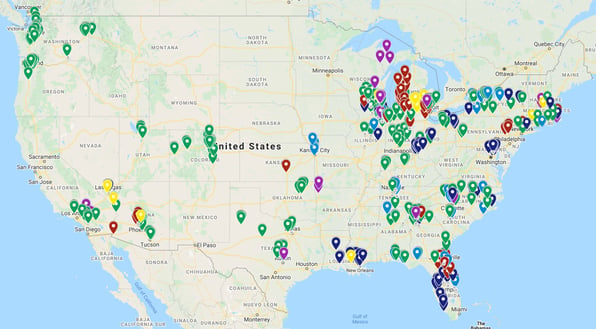Energy Efficiency | December 16, 2020
Looking at 2020 Energy Efficiency Numbers: Business Model of Sustainability
As I wrap up my six-month co-op experience at the Efficiency Solutions division of Mantis Innovation, I’m reminded of what initially drew me to the company. As a Business major with a concentration in Marketing at Northeastern University, the marketing opportunities at this co-op were great: a wide breadth of areas to explore within my major, and the ability to take ownership of my own projects. But as a company it also related to my own interests in sustainability, and, stemming from the business mindset, sustainability as a business proposition.
Now, almost 10 months after my initial, pre-pandemic interview, I have the opportunity to reflect on the results from energy efficiency over the rocky course of 2020, across the industry as a whole, as well as within the Efficiency Solutions division and its environmental equivalents. Let’s dive into the numbers:
How energy efficient the US was in 2020: Looking at the ACEEE Scorecard
Despite a tumultuous year, we’ve seen the continued growth of energy efficiency efforts and actions across the country, especially in some major US Markets. Every year, the American Council for an Energy-Efficient Economy (ACEEE) publishes scorecards showing the energy efficiency efforts of major cities, utility programs and other national and international trends relating to energy.
This year, New York, Boston and Seattle are leading the charge in efforts to reduce carbon emissions, often through increasing energy efficiency. While the West and Northeast are centers of strong energy efficiency, two cities in the Midwest, St. Louis and St. Paul, saw the most improvement over the past year.
Meanwhile, some of the utilities we frequently work with, including National Grid, Eversource, Con Edison and ComEd, have some of the best utility incentive programs in the country, providing great opportunities for businesses in these markets to complete their own energy projects.

Visual representation of FES projects in 2020
Our work in energy efficiency
Over the course of 2020, Mantis Innovation's Efficiency Solutions division engineered energy efficiency projects in 30+ different states, from New York to California, Florida to Washington, offering efficiency solutions from LED lighting and controls to BMS and data center optimization for hospitals, universities, supermarkets, biotech facilities and more. In a year marked by difficulties, these companies decided to reinvest in their infrastructures, lower their operational costs, improve their energy-dependent processes and increase their own sustainability.
From these projects initiated this year alone, our clients are saving a combined total of over 25 million kWh annually. At an average national cost of $0.1107 per kWh for commercial buildings, according to the US Energy Information Administration, these clients are saving over $2.82 million combined annually from decreased operational costs. In some regions where costs per kWh are significantly higher than the national average, such as New England or the west coast, these savings are huge for individual projects.
On average, these projects had an ROI of 38.2%, equal to 2.62 year payback period, meaning these projects that increase financial savings actually are paying for themselves, on average, in less than 3 years.
The environmental impact of energy efficiency
While these energy savings have large financial impacts for companies, they also have substantial environmental impacts that benefit surrounding communities.
From Mantis Innovation's Efficiency Solutions division's efficiency projects in 2020, the 28M kWh savings represent some significant carbon emission reductions, comparable to several more tangible environmental impacts. For example, this reduction in kWh is equal to taking 3,491 standard passenger cars off the road for a full year. Let’s look at other points of comparison for this annual kWh reduction:
- 2,064 household electricity use for one year
- 13,429 acres of pine or fir forests storing carbon for one year
- 17,455 conventional cars converted to hybrid cars
- 37,432 barrels of imported oil
This is what stands out to me about our work within energy efficiency – the clear environmental impacts that can be realized while simultaneously benefitting these companies. While it may seem impossible to ask 3,491 people to stop driving for an entire year, through energy efficiency projects that will also increase financial savings for companies, the same carbon emission reduction has been realized.
The State of Energy Efficiency in 2020
Looking back at 2020, what’s amazing is how so many places are becoming more energy efficiency and realizing the benefits, both financial and environmental, of decreasing their energy use. Businesses and communities across the country are continuing to invest in more efficient processes and energy systems and seeing the results.
Related Posts
Discover more content and insights from Mantis Innovation

The Cost of Inaction: Why Businesses Should Act Now on Energy Efficiency
In today's fast-paced business environment, the financial and operational losses businesses incur by delaying energy efficiency improvements, the "cost of inaction," is more relevant than ever.

In today’s AI era, human intelligence is the key to data center facility and energy optimization
Nowhere else in modern industry do artificial and human intelligence converge with such transformative potential as in the world of data centers. As AI's extraordinary growth accelerates demand for

Your Guide to LED Lighting for Business and Commercial Buildings
Never to be underestimated, LED lighting and well-designed lighting retrofits and upgrades offer businesses big improvements like reduced energy costs, reduced emissions, and improved working

Five Trends Driving Data Center Facility Energy Optimization
Today’s digital economy, commercial and industrial digitalization, and the recent explosion in artificial intelligence and machine learning (AI/ML) powered computing are driving massive growth in